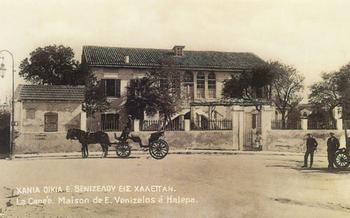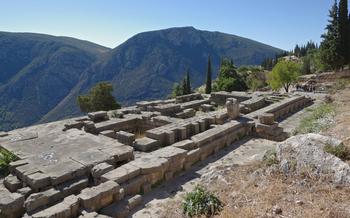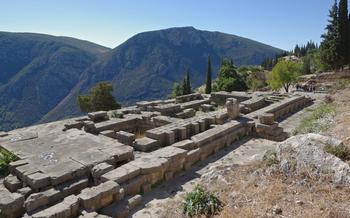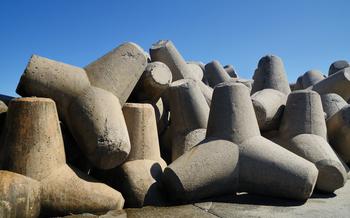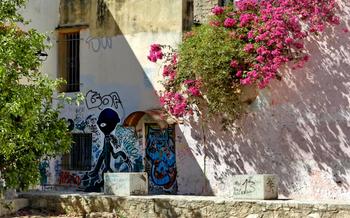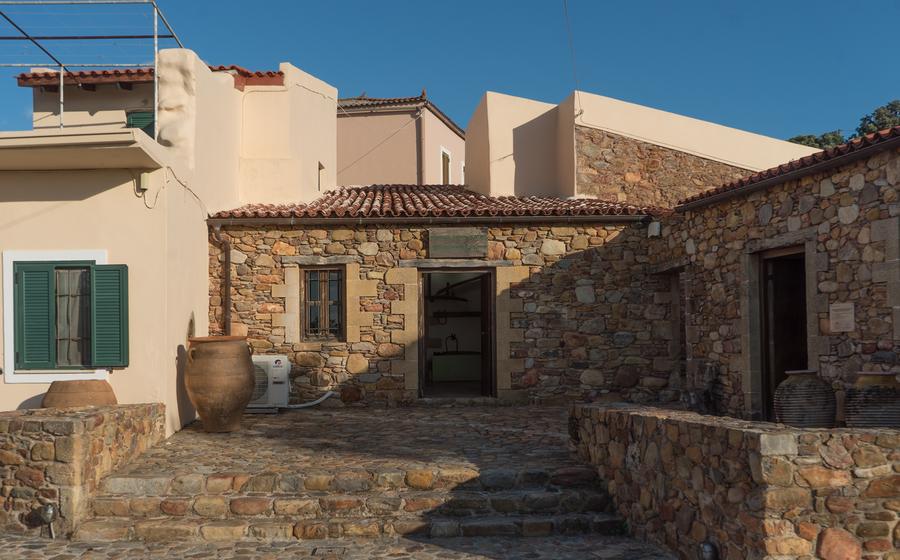
Olive Tree Museum of Vouves
- The Olive Tree Museum of Vouves: A Journey Through Time and Tradition
- History of the Museum
- Significance of Olive Trees in Crete
- Educational Exhibits and Displays
- Guided Tours and Workshops
- Unveiling the Ancient Olive Tree: A Symbol of Resilience
- Exploring the Museum's Exhibits: A Treasure Trove of Olive Knowledge
- Immersive Experiences: Workshops and Tastings
- A Walk Through the Olive Groves: A Sensory Delight
- Olive Oil and Gastronomy: A Culinary Adventure
- Shopping for Olive Oil Souvenirs: A Taste of Crete to Take Home
- Tips for Selecting High-Quality Olive Oil:
- Unique Olive Oil-Based Souvenirs and Gifts:
- Olive Oil and Health: A Natural Elixir
- Cultural Events and Festivals: Celebrating the Olive Harvest
- Olive Oil and Art: A Creative Expression
- Sustainable Tourism: Preserving the Olive Heritage
- Historical Significance: Olive Oil in Ancient Greece
- Photography Opportunities: Capturing the Olive Essence
- Educational Programs for Children: Nurturing Future Olive Enthusiasts
- Insider Tip: Embracing the Olive Oil Culture
The Olive Tree Museum of Vouves: A Journey Through Time and Tradition
Nestled in the heart of Crete, the Olive Tree Museum of Vouves stands as a testament to the deep-rooted connection between the island and its liquid gold - olive oil. Established in 2004, this unique museum offers visitors a comprehensive insight into the history, significance, and cultural heritage of olive trees in Crete. Through educational exhibits, guided tours, and hands-on workshops, the museum invites travelers to embark on a journey through time, exploring the ancient traditions and contemporary innovations that have shaped the world of olive oil.
History of the Museum
The Olive Tree Museum of Vouves was founded on the initiative of the local community, recognizing the need to preserve and promote the rich olive-growing heritage of the region. The museum is housed in a beautifully restored traditional Cretan building, offering a warm and welcoming ambiance for visitors to delve into the world of olives.
Significance of Olive Trees in Crete
Olive trees hold a profound significance in Crete, where they have been cultivated for millennia. The island's unique climate and geography provide ideal conditions for olive trees to thrive, resulting in the production of some of the finest olive oil in the world. The museum showcases the diverse varieties of olive trees found in Crete, highlighting their unique characteristics and the role they play in the local economy and culture.
Educational Exhibits and Displays
The museum's exhibits offer a wealth of information about olive trees and olive oil production. Visitors can learn about the history of olive cultivation in Crete, the different stages of olive oil production, and the traditional tools and techniques used by local farmers. Interactive displays and multimedia presentations bring the exhibits to life, providing visitors with a comprehensive understanding of the olive oil-making process.
Guided Tours and Workshops
Guided tours of the museum are available for visitors who wish to delve deeper into the world of olives. Experienced guides share their knowledge about the history, cultivation, and production of olive oil, offering visitors a personalized and enriching experience. Additionally, the museum offers hands-on workshops on olive oil tasting and olive oil production, providing visitors with a unique opportunity to learn from local experts and create their own olive oil.
Unveiling the Ancient Olive Tree: A Symbol of Resilience
At the heart of the Olive Tree Museum of Vouves lies an awe-inspiring sight: the ancient olive tree, a living testament to the enduring spirit of Crete. Believed to be over 3,000 years old, this venerable tree stands as a symbol of resilience, having weathered countless storms, droughts, and the passage of time. Its gnarled trunk and expansive canopy, stretching over 13 meters in diameter, exude an aura of ancient wisdom and strength.
Legends and myths have woven themselves around this remarkable tree, adding to its mystique. It is said that the tree was planted by the goddess Athena, who gifted it to the people of Crete as a symbol of peace and prosperity. According to another legend, the tree served as a meeting place for the gods, who gathered beneath its shade to discuss the fate of the world.
Today, the ancient olive tree stands as a protected monument, a symbol of Greek heritage and the enduring connection between humanity and nature. Conservation efforts are meticulously undertaken to ensure its well-being, preserving this natural treasure for generations to come. The tree's resilience serves as a reminder of the strength and adaptability of the human spirit, capable of overcoming adversity and thriving even in the face of the most challenging circumstances.
Exploring the Museum's Exhibits: A Treasure Trove of Olive Knowledge
The Olive Tree Museum of Vouves houses a wealth of exhibits that delve into every aspect of olive cultivation and olive oil production. Visitors can embark on an educational journey through interactive displays, traditional tools, and captivating artifacts.
One of the highlights is the section dedicated to olive oil production techniques. Here, visitors can learn about the ancient methods used to extract oil from olives, including the use of stone mills and traditional presses. The museum showcases a variety of these traditional tools, providing a tangible connection to the rich history of olive oil making in Crete.
Another fascinating exhibit focuses on olive tree cultivation practices. Visitors can explore the different varieties of olive trees grown in Crete, each with its own unique characteristics and flavor profile. Interactive displays explain the importance of factors such as soil conditions, climate, and pruning techniques in producing high-quality olives.
The museum also sheds light on the diverse range of olive-based products and their significance in Cretan culture. From traditional soaps and cosmetics to medicinal ointments and wood carvings, visitors can discover the many ways in which olives have been utilized throughout history.
Immersive Experiences: Workshops and Tastings
At the Olive Tree Museum of Vouves, visitors can delve deeper into the world of olive oil through a variety of immersive experiences. Olive oil tasting sessions are a highlight, offering the chance to sample different varieties and learn about their unique flavors and aromas. Guided by experts, participants discover the nuances of olive oil and develop a refined palate.
Hands-on workshops provide a unique opportunity to learn about olive oil production firsthand. Visitors can participate in the traditional process of extracting oil from olives, using ancient techniques and tools. These workshops offer a glimpse into the history and culture of olive oil production, while also providing a fun and educational experience.
Cooking demonstrations showcase the versatility of olive oil in Cretan cuisine. Skilled chefs create delicious dishes using olive oil as a key ingredient, demonstrating its ability to enhance flavors and create culinary masterpieces. Participants can watch, learn, and savor the delectable creations, gaining insights into the culinary traditions of Crete.
Interactive exhibits add another dimension to the museum experience. Through interactive displays and multimedia presentations, visitors can explore the science, history, and cultural significance of olive oil. Games, quizzes, and touchscreens engage visitors of all ages, making learning about olive oil both enjoyable and memorable.
A Walk Through the Olive Groves: A Sensory Delight
Beyond the museum's walls lies an enchanting world of olive groves, inviting visitors to embark on a sensory journey. The air is filled with the intoxicating aroma of olives, mingled with the earthy scent of the soil. As you stroll along the paths winding through the groves, the rhythmic rustling of leaves creates a serene symphony.
The olive trees stand tall and majestic, their silver-green foliage shimmering in the sunlight. Their gnarled trunks, etched with the marks of time, tell stories of resilience and longevity. The groves offer a kaleidoscope of colors, from the deep green of the leaves to the vibrant yellow of the ripening olives.
Guided walks led by knowledgeable guides provide an immersive experience, as they share insights into the different olive tree varieties, their cultivation practices, and the secrets behind producing the finest olive oil. Visitors can learn about the unique microclimate of Crete, which contributes to the exceptional quality of the olives grown here.
Pausing beneath the shade of an ancient tree, one can truly appreciate the tranquility of the groves. The gentle breeze carries the sound of birdsong, and the only other sound is the crunch of your footsteps on the gravel path. It's a moment to reconnect with nature, to feel the energy of these ancient trees, and to savor the essence of the Cretan landscape.
Olive Oil and Gastronomy: A Culinary Adventure
Olive oil is not just a condiment in Crete; it's a way of life. Cretan cuisine is heavily reliant on olive oil, which adds a unique flavor and aroma to both savory and sweet dishes. Traditional dishes like dakos (a barley rusk topped with tomatoes, feta cheese, and olive oil), gamopilafo (a saffron-infused rice dish with lamb or chicken), and kalitsounia (fried or baked pastries filled with cheese, herbs, and olive oil) showcase the versatility and deliciousness of this liquid gold.
Olive oil is also a key ingredient in the famous Mediterranean diet, which is renowned for its health benefits. The high concentration of monounsaturated fats, antioxidants, and polyphenols in olive oil contributes to heart health, reduces inflammation, and may even help prevent certain types of cancer.
For a true taste of Cretan cuisine, visit local restaurants that specialize in traditional dishes. Many tavernas and restaurants in Chania offer olive oil-based delicacies, such as grilled octopus with olive oil and lemon, slow-cooked lamb with potatoes and olive oil, and fresh seafood drizzled with the finest extra virgin olive oil. A visit to the Olive Tree Museum of Vouves is not just a journey through history and tradition; it's also a culinary adventure that will tantalize your taste buds and leave you with a deep appreciation for the liquid gold of Crete.
Shopping for Olive Oil Souvenirs: A Taste of Crete to Take Home
The Olive Tree Museum of Vouves offers a delightful opportunity to purchase a variety of olive oil products as souvenirs, allowing you to take a taste of Crete back home. From bottles of premium extra virgin olive oil to unique olive oil-based cosmetics and culinary specialties, there's something for every taste and budget.
Tips for Selecting High-Quality Olive Oil:
- Color: Look for a vibrant golden-green color, indicating freshness and high-quality extraction.
- Acidity: Choose olive oil with low acidity levels, typically below 0.8%, for a smoother taste and longer shelf life.
- Harvest Date: Opt for olive oil from the most recent harvest for the best flavor and nutritional value.
- Protected Designation of Origin (PDO): Look for the PDO label, which guarantees that the olive oil is produced in a specific region using traditional methods.
Unique Olive Oil-Based Souvenirs and Gifts:
- Olive Oil Soap: Indulge in the gentle cleansing properties of handmade olive oil soap, naturally moisturizing and enriched with the goodness of olive oil.
- Olive Oil Cosmetics: Discover a range of olive oil-based skincare products, including body lotions, lip balms, and hair care treatments, all harnessing the nourishing and rejuvenating benefits of olive oil.
- Olive Wood Crafts: Choose from a selection of handcrafted olive wood items, such as kitchen utensils, bowls, and decorative pieces, each showcasing the unique grain and texture of the olive tree.
By purchasing olive oil souvenirs from the museum, you not only support local producers and the Cretan economy but also bring home a piece of the island's rich olive oil heritage to cherish and enjoy.
Olive Oil and Health: A Natural Elixir
Olive oil has been revered for its health benefits since ancient times. Modern science has confirmed that this liquid gold is a powerhouse of nutrients and antioxidants. The monounsaturated fats in olive oil help reduce LDL (bad) cholesterol and increase HDL (good) cholesterol, thus lowering the risk of heart disease. Olive oil also contains polyphenols, which have anti-inflammatory and antioxidant properties. These compounds may protect against various chronic diseases, including cancer.
Incorporating olive oil into a healthy lifestyle is simple yet effective. Use olive oil as a primary cooking oil, drizzle it over salads and vegetables, and use it as a marinade for meats and fish. Olive oil can also be used in baking and desserts, adding a subtle flavor and richness.
Beyond its culinary benefits, olive oil has been used as a natural remedy for centuries. It has antibacterial and antifungal properties, making it effective in treating skin infections and wounds. Olive oil is also known to relieve constipation and improve digestive health.
Whether you're using it for cooking, health, or beauty, olive oil is a versatile and beneficial addition to your daily life. Embrace the Mediterranean diet and enjoy the many health-promoting properties of this liquid gold.
Cultural Events and Festivals: Celebrating the Olive Harvest
Chania bursts into life during the olive harvest season as the region celebrates its rich olive oil heritage with a series of lively festivals and events. These cultural extravaganzas offer a fantastic opportunity to immerse yourself in the traditions of olive harvesting and to sample the delicious local produce.
The Olive Harvest Festival, held annually in the picturesque village of Vouves, is a highlight of the season. The festival showcases the traditional methods of olive harvesting and oil production, with demonstrations, workshops, and exhibitions. Visitors can witness the transformation of olives into the liquid gold of Crete, while enjoying traditional music, dancing, and feasting on local delicacies.
Other villages and towns in the region also host their own olive harvest celebrations, each with its unique charm and character. These festivals provide a vibrant platform for local farmers and producers to showcase their finest olive oil and other olive-based products, while also promoting the region's rich culinary heritage.
By attending these events, visitors can not only delve into the world of olive oil production but also experience the warm hospitality and vibrant culture of Crete. So, if you happen to be in Chania during the olive harvest season, be sure to join the festivities and embrace the spirit of this ancient tradition.
Olive Oil and Art: A Creative Expression
Olive oil has been not only a source of sustenance and nourishment but also a muse for artistic expression. The Olive Tree Museum of Vouves hosts art exhibitions and installations that showcase the creative interpretations of olives and olive oil by local and international artists. These exhibitions range from traditional paintings and sculptures to contemporary installations and multimedia displays.
The museum provides a platform for artists to explore the unique characteristics and symbolism of olive oil, using it as a medium for their creative expression. Visitors can admire the intricate details of olive-themed paintings, the elegant forms of olive oil-inspired sculptures, and the captivating visuals of interactive olive oil-themed installations.
Workshops on olive oil-themed crafts and activities are also organized periodically, allowing visitors to engage in hands-on experiences and create their own olive-inspired artwork. These workshops are an excellent opportunity to learn about the creative potential of olive oil and to unleash one's own artistic talents.
Local artists in Chania often draw inspiration from the olive tree and its significance in Cretan culture. Their works can be found in galleries, studios, and art shops throughout the city, offering visitors a unique perspective on the cultural and artistic heritage of Crete.
Sustainable Tourism: Preserving the Olive Heritage
Sustainable tourism practices are crucial for preserving the olive heritage of Chania and ensuring the longevity of the Olive Tree Museum of Vouves. Visitors can contribute to sustainability by adhering to responsible practices during their visit. This includes respecting the environment by avoiding littering, staying on designated paths, and minimizing water usage. Supporting local communities is essential, whether by purchasing olive oil products directly from local producers or dining at restaurants that prioritize local ingredients. Visitors can also choose to stay in eco-friendly accommodations that prioritize sustainability and minimize their carbon footprint. By embracing sustainable practices, tourists can help protect the delicate ecosystem of the olive groves and ensure that future generations can continue to enjoy the benefits of this ancient tree.
Historical Significance: Olive Oil in Ancient Greece
Olive oil holds a significant place in the history of ancient Greece. It was a precious commodity, a symbol of wealth, health, and fertility. Archaeological excavations in Crete have unearthed evidence of olive oil production dating back to the Minoan civilization, showcasing the deep-rooted connection between olives and the island's history. In ancient Greek mythology, the olive tree was sacred to the goddess Athena, who was believed to have gifted the first olive tree to the city of Athens. Olive oil was used in religious ceremonies, as a fuel for lamps, and as a valuable trading commodity. Its versatility and symbolism made it an integral part of ancient Greek culture and economy.
Photography Opportunities: Capturing the Olive Essence
The Olive Tree Museum of Vouves provides a picturesque backdrop for photography enthusiasts. With its ancient olive tree, lush olive groves, and traditional Cretan architecture, the museum offers a wealth of photogenic opportunities.
Capture the majesty of the ancient olive tree, with its gnarled trunk and sprawling branches. Experiment with different angles and lighting conditions to capture the tree's unique character.
Stroll through the olive groves surrounding the museum, capturing the beauty of the silver-green leaves and the patterns created by the rows of trees. The groves offer a serene and picturesque setting for landscape photography.
Don't miss the opportunity to photograph the traditional Cretan architecture of the museum buildings. The whitewashed walls, arched doorways, and colorful shutters add a touch of charm and authenticity to your shots.
For Instagrammable moments, capture the essence of the Cretan olive oil culture. Photograph local farmers harvesting olives, women making traditional olive oil soap, or families enjoying a meal featuring olive oil-based dishes.
Share your olive-inspired photographs with the world, using hashtags like #OliveTreeMuseumVouves, #OliveOilCrete, and #OliveMoments. Inspire others to discover the beauty and traditions of this ancient land.
Educational Programs for Children: Nurturing Future Olive Enthusiasts
The Olive Tree Museum of Vouves offers a range of educational programs and activities tailored to children, fostering their curiosity and appreciation for the olive tree and its significance. Through interactive exhibits, games, and hands-on experiences, young visitors embark on a journey of discovery, learning about the history, cultivation, and uses of olive trees. These programs aim to inspire the next generation of olive enthusiasts, cultivating a deep understanding and respect for this ancient symbol of Crete.
Insider Tip: Embracing the Olive Oil Culture
Beyond your visit to the Olive Tree Museum of Vouves, there are countless ways to delve deeper into the olive oil culture of Crete. Embrace the local customs and traditions that revolve around this liquid gold. Start by incorporating olive oil into your daily cooking, experimenting with different varieties and flavors. Discover the art of using olive oil not just as a condiment, but as a key ingredient that enhances the taste of your dishes.
Seek out local restaurants and shops that specialize in olive oil and olive oil-based products. Indulge in traditional Cretan cuisine, where olive oil takes center stage. From simple salads drizzled with fresh, peppery oil to hearty stews and grilled meats infused with its rich flavor, each dish showcases the versatility and culinary magic of olive oil.
Participate in events and workshops that celebrate the olive harvest and olive oil production. These immersive experiences offer a chance to learn from local farmers and producers, witness the traditional methods of olive oil making, and taste the freshest olive oil straight from the source. Engage with the community, ask questions, and gain a deeper understanding of the passion and dedication behind this ancient craft.
By embracing the olive oil culture, you not only savor the delicious flavors of Crete, but also contribute to the preservation and promotion of this timeless tradition. Support local producers, connect with the land, and create lasting memories that capture the essence of the Olive Tree Museum of Vouves and the vibrant olive oil heritage of Chania.

